#long haired cats
Text


Tommy the Cat and his sister, Tabitha (also a cat) are housed and cared for by a pair of disabled neurodivergent humans who are living around the poverty level. Bills are paid (sometimes with help from relatives), but there's very little for anything else. If you'd like to help out, we have a couple of wishlists (one for the humans and one for the kitties).
#cat#cats#floofs#cats of tumblr#catblr#floofs of tumblr#cat photos#cat photography#long haired cats#tuxedo cat#tuxedo tabby#tommy the cat#tabitha (also a cat)
9 notes
·
View notes
Text
the way he jumps when i start talking lol
17 notes
·
View notes
Text
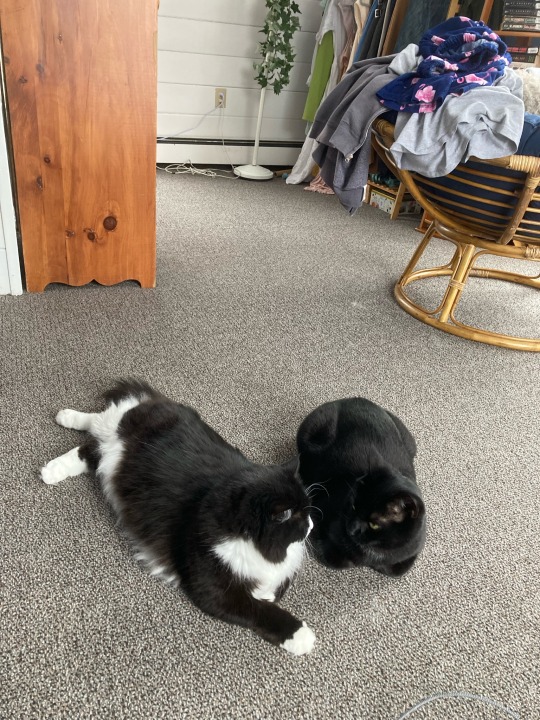

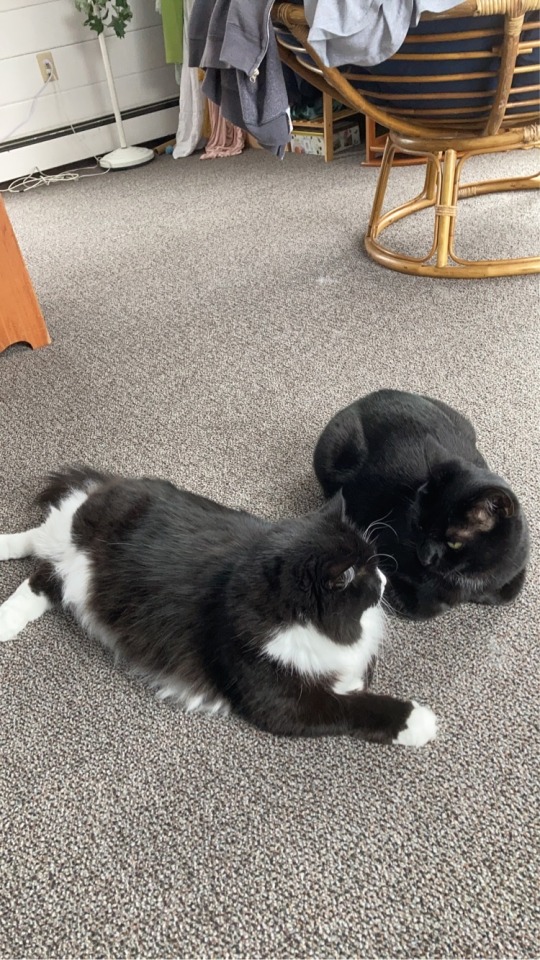
Why are they sitting so close
#photos#photography#cat#cats#black cat#black cats#black and white#long haired cat#long haired cats#long haired tuxedo cat#long haired tuxedo cats#Radio#Mordecai
10 notes
·
View notes
Text
Orange Cat AKA Sunshine Update
After he crawled into my lap a few weeks back I had a moment where I was sure he was ready to be picked up. Hoisted him up onto my lap while I was sitting in a chair and he was totally fine.
He’s a lap cat now and he CANNOT GET ENOUGH pets and affection. 🥹
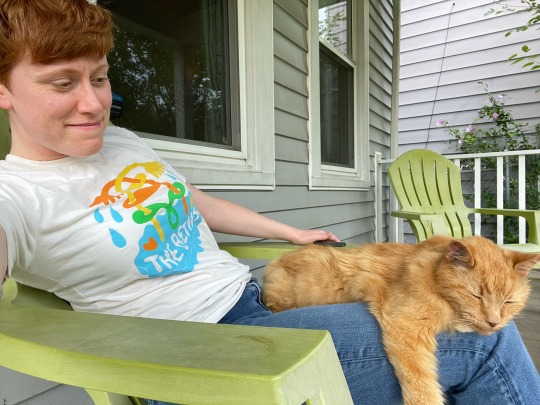

Yesterday we began Adventures in Brushing & Grooming.
Here is a big orange tuft as well as video of Mr. Baby Man discovering his own face on camera:

#i will take any advice on grooming a longhaired cat#he has some huge established mats where his chest meets his underside#i don’t know what i’m doing & his behavior isn’t predictable enough to feel comfortable coming that close to his whiskers with clippers#he’s still not in a place where i could bring a professional groomer to him#am hoping i can just pick the mats out slowly over time with the flea & tick comb?#street cat saga continues#cats#orange cat#sunshine#long haired cats
3 notes
·
View notes
Text
•Pookie• 🐈⬛️
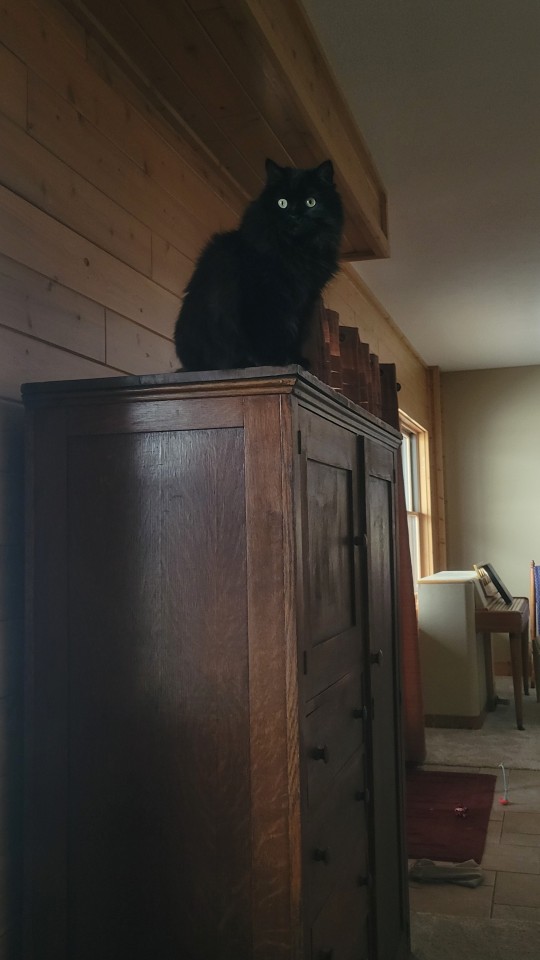
She kinda reminds me of a gargoyle whenever she sits on the ledge like that
#cute#catlover#cute cats#cat#adoptashelterpet#adoptdontshop#cats of tumblr#sleeping cats#tabby#black cat#black cats#long haired cats
9 notes
·
View notes
Text
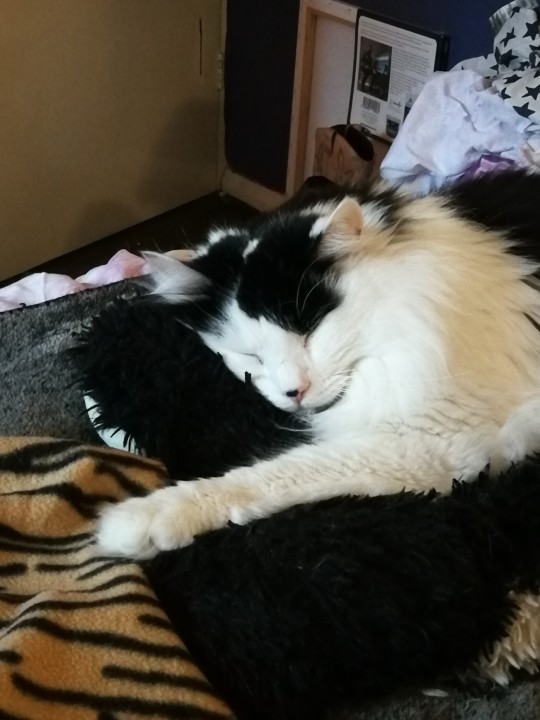
I just adore my Belphie.
#cats of tumblr#tumblr cats#Cute cats#Belphie the cat#Belphegor#Fluffuness#Super fluff#Long haired cats
1 note
·
View note
Text
♡♡♡

1 note
·
View note
Text


Words to Live by!
5K notes
·
View notes
Text
Don't Let Your Long-Haired Cat Lead To Sanitary Issues: Take Special Care
Do you have a long-haired cat? While these felines are stunning to look at, they require extra care to maintain their hygiene. Neglecting your cat's grooming needs can lead to a variety of sanitary issues that can impact your cat's health and well-being.
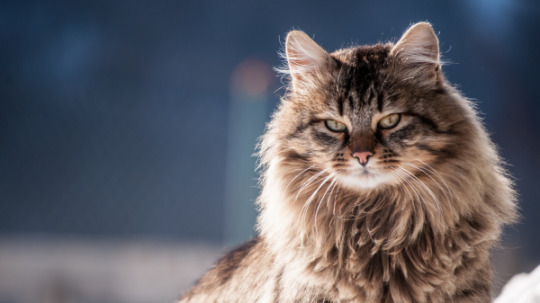
In this article, we'll explore the common sanitary issues that long-haired cats face and provide you with the necessary grooming techniques to prevent them. We'll also discuss preventive measures you can take to avoid these issues altogether.
With the right care, you can ensure that your long-haired cat stays healthy and happy for years to come.
Common Sanitary Issues for Long-Haired Cats
Don't let your long-haired kitty suffer from avoidable health problems - learn about the most common sanitary issues they face!
One of the most common issues is hair matting. When a cat's fur becomes excessively tangled and matted, it can cause discomfort and pain. It can also trap dirt and debris, leading to skin irritation and infections. Long-haired cats are especially prone to matting, which is why it's important to groom them regularly.
Skin infections are another common issue for long-haired cats. When their fur is not properly maintained, it can become a breeding ground for bacteria and fungi. This can lead to skin infections, which can be very uncomfortable and even painful for your cat. Symptoms of a skin infection include redness, itchiness, and scabbing. If you notice any of these symptoms, it's important to take your cat to the vet right away.
To prevent these common sanitary issues, it's important to groom your long-haired cat regularly. This includes brushing their fur daily to prevent matting, as well as bathing them every few months to keep their coat clean.
In the next section, we'll discuss grooming techniques for long-haired cats in more detail. By taking good care of your cat's fur, you can help them stay healthy and happy.
Grooming Techniques for Long-Haired Cats
To keep your feline friend looking and feeling their best, regularly incorporating grooming into your routine is essential, especially for those with longer locks. Long-haired cats are prone to developing mats, which can lead to skin irritations and infections.
To prevent this from happening, use these grooming techniques for your furry friend:
Detangling mats: Long-haired cats are prone to developing mats, which can be painful and hard to remove. To detangle mats, use a metal comb or brush with long teeth. Start by gently combing the edges of the mat, then work your way inwards. If the mat is too difficult to remove, you may need to cut it out with scissors, being careful not to cut your cat's skin.
Trimming fur: Trimming your cat's fur can help prevent mats from forming, especially in areas like the belly and armpits. Use a pair of scissors or clippers with a comb attachment to trim the fur to a manageable length. Be careful not to cut your cat's skin or fur too short, as this can cause irritation.
Cleaning eyes and ears: Long-haired cats are also prone to developing eye and ear infections, as their fur can trap dirt and bacteria. Use a damp cloth or cotton ball to gently clean around your cat's eyes and ears, being careful not to get water in their ears. If you notice any discharge or unusual odor, contact your veterinarian.
By regularly grooming your long-haired cat, you can help prevent sanitary issues and keep them healthy and happy. However, grooming is just one preventive measure. In the next section, we'll discuss other ways to keep your cat healthy and prevent future issues.
Preventive Measures
To maintain the health of your long-haired cat, you must take preventive measures. Make sure to provide a clean litter box for your feline friend.
Regular vet check-ups are also necessary to ensure that your cat stays healthy and free from any potential diseases.
Additionally, a proper diet and hydration will help your cat stay in optimal condition.
Providing a Clean Litter Box
Keeping your long-haired cat's litter box clean is essential for their health and well-being. Due to their long hair, they may have a higher risk of developing urinary tract infections and other health issues if their litter box is not cleaned frequently enough.
Cleaning frequency depends on the number of cats using the box and the litter type. Generally, it's recommended to scoop the litter box at least once a day and empty it completely once a week. However, if you have multiple cats, you may need to scoop more frequently to keep the litter box clean.
Choosing the right litter type is also important. Clumping litter is often preferred by cat owners because it makes scooping easier. However, this type of litter may not be the best option for long-haired cats as the litter can clump to their fur and cause hygiene issues. Non-clumping litter or shredded paper may be a better choice for long-haired cats.
By providing a clean litter box and choosing the appropriate litter type, you can help prevent health issues in your long-haired cat. Regular vet check-ups are also important for maintaining your cat's health, so be sure to schedule appointments as needed.
Regular Vet Check-Ups
Regular vet check-ups are important for keeping your long-haired cat healthy and happy. Your cat's coat may look beautiful and luxurious, but it also means that more hair can accumulate and cause health problems.
During a vet check-up, your veterinarian can examine your cat's coat and skin, ensuring that any potential issues are addressed before they become serious. Additionally, regular check-ups allow for catching and treating any diseases or conditions early on, leading to better outcomes for your furry friend.
It's important to note that vaccinations and parasite prevention measures are crucial components of regular vet check-ups. Your vet can advise you on which vaccinations your cat needs based on their lifestyle and risk factors.
Parasites, such as fleas and ticks, can cause a multitude of problems, including skin irritation, anemia, and even disease transmission. Your vet can recommend the best parasite prevention measures for your cat, such as topical or oral medications.
By staying up-to-date on vaccinations and parasite prevention, you can help ensure the health and happiness of your long-haired cat. And speaking of health, let's move onto the next section about how proper diet and hydration can also benefit your furry friend.
Proper Diet and Hydration
As mentioned earlier, regular trips to the vet are essential in keeping your long-haired cat healthy. However, another crucial aspect of maintaining your feline's well-being is through proper diet and hydration.
Long-haired cats are more prone to urinary tract infections and other related health issues, so it's crucial to keep them well-hydrated and ensure they're on the right diet. Balancing moisture intake is key in preventing urinary tract infections. One way to achieve this is by incorporating wet food options into your cat's diet. Wet food has a higher moisture content than dry food, which helps keep your cat hydrated.
Additionally, monitoring your cat's water intake is crucial in avoiding dehydration. Ensure your cat has clean water available at all times and consider using a water fountain to encourage drinking. By keeping your cat's hydration levels in check, you can prevent potential health issues down the line.
As important as it is to keep your cat healthy, you also need to ensure that their long hair doesn't lead to any sanitary issues. The next section will delve into ways of managing these issues.
Managing Sanitary Issues
To prevent any unpleasant odors, it's important to stay on top of grooming your long-haired cat. Hygiene habits play a crucial role in keeping your cat clean and healthy. Cats groom themselves regularly, but long-haired cats need extra attention. You can help by brushing them daily to prevent matting and tangling. Regular grooming also helps to distribute natural oils throughout their fur, keeping it healthy and shiny.
Sanitation tips are also important to keep in mind when caring for a long-haired cat. Litter boxes should be kept clean and changed regularly to prevent the buildup of bacteria and odors. It's also important to keep your cat's sleeping area and food and water bowls clean and sanitized. This will help prevent the spread of germs and keep your cat healthy and happy.
If you notice any unusual odors or discharge from your cat, it's important to take them to the vet right away. This could be a sign of an infection or other health issue.
By staying on top of your cat's grooming and sanitation needs, you can help prevent these issues and keep your long-haired cat healthy and happy.
Frequently Asked Questions
How often should I bathe my long-haired cat?
To maintain your long-haired cat's hygiene, bathe them every 4-6 weeks. However, frequent bathing can strip their coat of natural oils. Brushing should be done daily to prevent matting and hairballs, promoting a healthy coat.
Can I trim my cat's fur at home or should I take them to a professional groomer?
When it comes to trimming your long-haired cat's fur, you can do it at home with the right tools and techniques. However, professional grooming offers benefits like expert handling and specialized equipment. Here are some home grooming tips to get you started.
Are there any specific shampoos or grooming products that are recommended for long-haired cats?
To keep your long-haired cat healthy and clean, use the best grooming techniques and natural grooming remedies. Look for shampoos designed specifically for long-haired cats to help prevent matting and tangles.
Is it normal for long-haired cats to get hairballs, and if so, how can I prevent them?
Long-haired cats are prone to hairballs, which can lead to digestive issues. Feeding your cat a high-fiber, low-fat diet can help prevent hairballs. Hairball remedies, such as petroleum jelly or specialized cat treats, can also be effective.
Are there any health issues that are more common in long-haired cats than in short-haired cats?
Long-haired cats are more prone to skin issues such as matting, dandruff, and infections. Regular grooming routine including brushing, bathing, and trimming can prevent these issues. Consult a veterinarian for any skin concerns.
Great Resource: How To Stop a Cat From Spraying Indoors
Conclusion
In conclusion, taking care of your long-haired cat is crucial to prevent sanitary issues that can affect their health and your household. Regular grooming can prevent matting and hairballs, but also provide an opportunity for bonding with your cat. While preventive measures such as litter box placement and cleaning can reduce the risk of urinary tract infections and other issues.
One pet owner shared a story of how her long-haired cat's neglect led to a sanitary issue. She compared it to neglecting to clean the lint trap in your dryer, where eventually, it can cause a fire.
The same goes for your cat's hygiene. Neglecting it can lead to serious health issues that could have been prevented with proper care. In the end, taking care of your long-haired cat requires effort, but it's worth it for their health and the safety of your household.
Remember to groom regularly, take preventive measures, and seek veterinary care if necessary. Your cat will thank you for it.
youtube
0 notes
Text
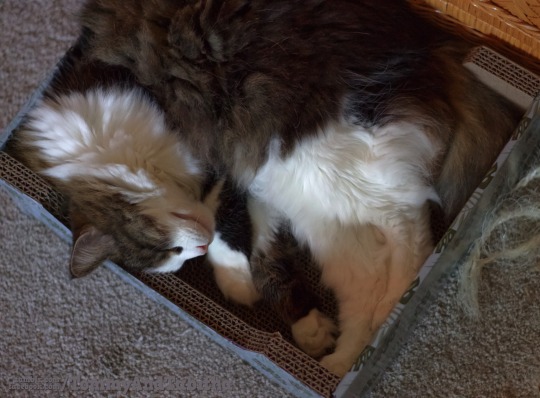
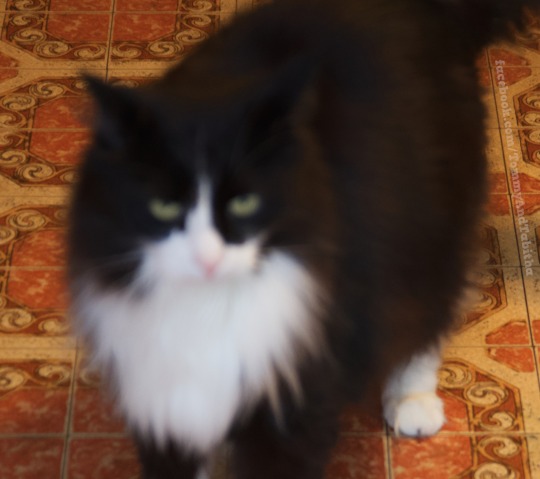
our linktree
#cat#cats#floofs#catblr#cats of tumblr#floofs of tumblr#cat pictures#cat photos#tommy the cat#tabitha (also a cat)#long haired cat#long haired cats#tuxedo cat#tuxedo tabby#tuxedo cats
8 notes
·
View notes
Text
kitty kitty
5 notes
·
View notes
Text

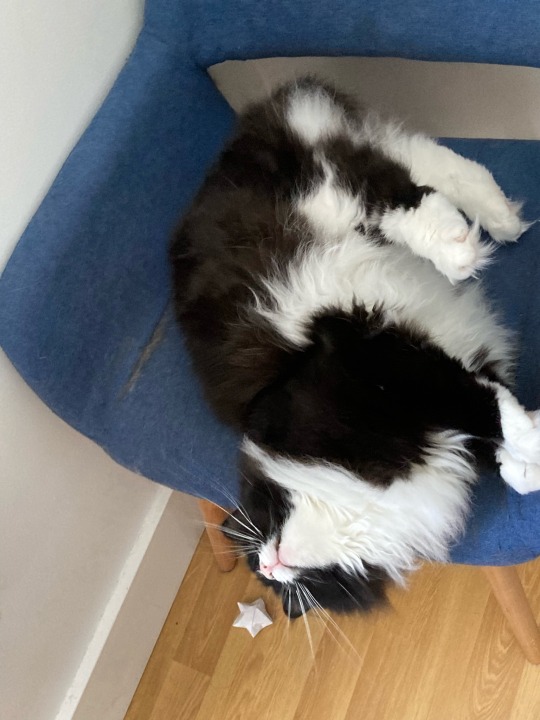
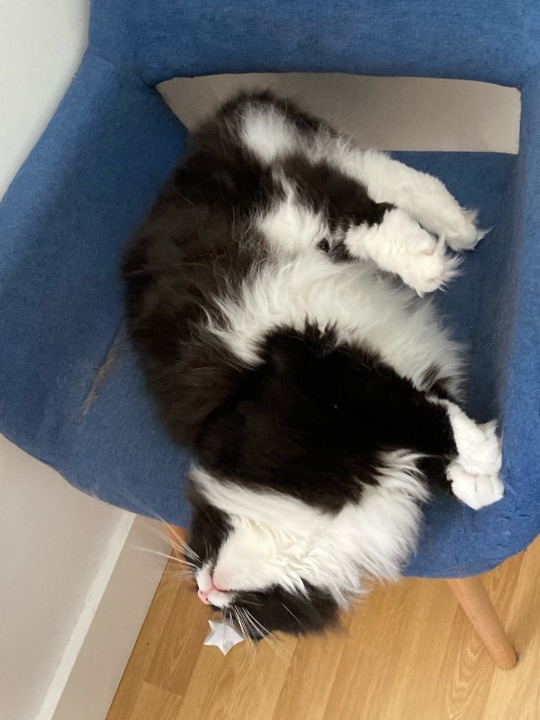
#photos#photography#cat#cats#black and white#tuxedo#tuxedo cat#tuxedo cats#long haired cat#long haired cats#long haired tuxedo cat#long haired tuxedo cats#Radio
18 notes
·
View notes
Text

0 notes
Text
Missy~

Gahhh look at her with her cute new collar :-) it compliments her fur so well 💙💙
#cute#catlover#cute cats#cat#adoptashelterpet#adoptdontshop#cats of tumblr#sleeping cats#tabby#black cat#grey cat#gray cat#nebelung#russian blue#long haired cats#cats
3 notes
·
View notes
Text
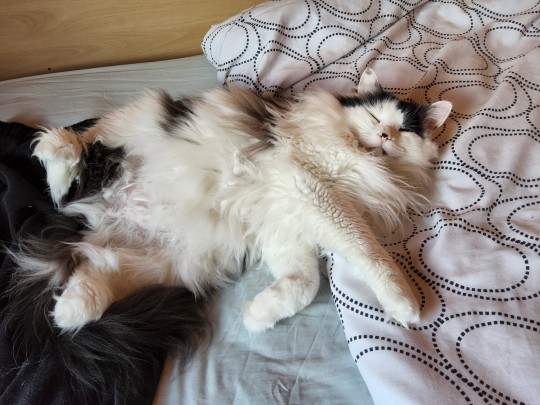
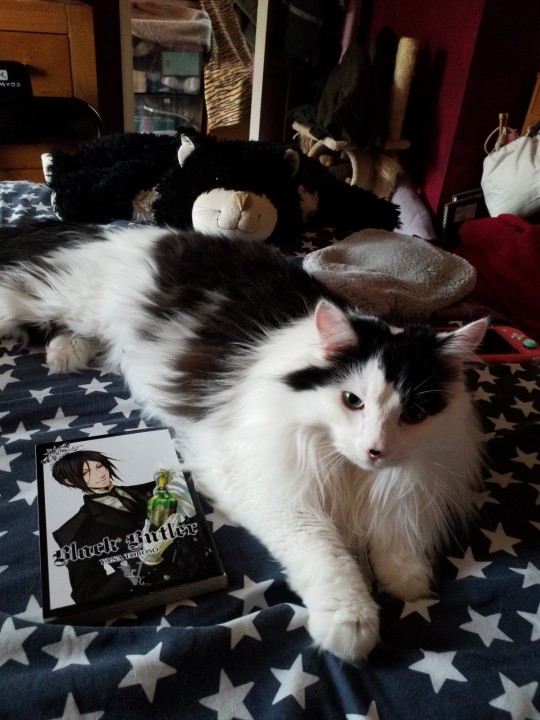

This UK heatwave has been tough on Belphegor. I keep trying to get him used to my desk fan. So far though he's taken to laying on my bathroom floor.
How do you keep your long haired cats cool?
#fluffy belphie#belphie boo#belphie the cat#belphegor the cat#long haired cats#fluffy cats#four kittens of the apocalypse on instagram
0 notes